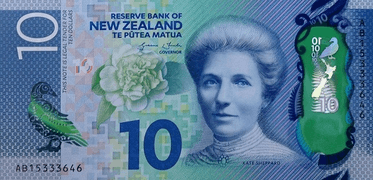New Zealand ten-dollar note
| (New Zealand) | |
|---|---|
| Value | 10 New Zealand dollar |
| Width | 140 mm |
| Height | 68 mm |
| Security features | Window, shadow image |
| Paper type | Polymer |
| Years of printing | 1999-present[1] |
| Obverse | |
 | |
| Design | Kate Sheppard |
| Design date | October, 2015[2] |
| Reverse | |
| Design | Whio, River Scene[3] |
| Design date | October, 2015 |
The New Zealand ten-dollar note is a polymer banknote. It was issued in 1999 from the Reserve Bank of New Zealand. Two commemorative banknotes have also been issued. One of the notes was to celebrate New Zealand's Treaty of Waitangi and was released in 1990. Another polymer banknote was issued in 1999 to celebrate the new millennium.[3]
Design
1990 commemorative banknote
A ten-dollar note was issued by the Reserve Bank of New Zealand to celebrate New Zealand's Treaty of Waitangi in 1990. The front of the bill has a portrait of Elizabeth II. To the right of the portrait is a red circle with a bird with the year "1990" underneath the circle. The back shows the treaty being signed by a group of people. To the right of the treaty being signed reads "New Zealand 1990 commemorating the signing of the Treaty of Waitangi 1840". The bill is made of cotton and the most prominent color is purple.[3] The value is around $20(USD) to a collector.[4]
1999-2000 polymer banknote millennium
The Reserve Bank of New Zealand issued a note in 1999 to celebrate the new millennium in New Zealand. The ten-dollar bill is a polymer banknote, which is more secure than the cotton ones. Around 15,000 notes were put into circulation. The most used color is dark blue. New Zealand can be seen in the upper left corner with the planet earth behind it.. There is a see-through window on the left with metallic ink in the shape of a fern. On the back are surfers and boats which have Māori people in them and a water skier. There is a perfect register of a sea shell in the lower left corner next to the map of New Zealand. When held up to light the shell(s) should be a perfect match.[5]
First issue (1967 to 1981)
On the front of the note is a portrait of Kate Sheppard. The note has a blue background. On the back is a bird called a kea, a parrot. The kea is perched on a mountain lilly, which has large waxy flowers. There also is a watermark of Captain James Cook.
Second issue (1982 to 1990)
There is little difference in the design except the portrait of the Queen and added colors.
Third issue (1990 to 1999)
The notes were completely re-designed in the 1990s. This series uses the same designs as the current polymer series. The main differences are the notes are cotton-based not polymer. Another design element is a metallic stripe to the left of Kate Sheppard. There is also a latent image on the front in the upper -right hand corner of the note.[6][7]
Fourth issue (1999 to present)
Sheppard, a woman who pressed for women's suffrage in New Zealand, the first nation to have voting rights for women, in 1893, is now on the front. The flower pictured next to her is the white camellia, a symbol for universal suffrage for New Zealand. On the back is the whio or a blue duck. This bird is an endangered species in New Zealand. Between the portrait and the camellia is a map of New Zealand. The note has a light blue background with ferns.[3][8]
Security features
The note has a see-through window of a fern on the left and another on the right. When the bill is shown to the light, a watermark of Elizabeth II are displayed. There is intaglio printing through the bill which gives it an embossed feel. Under UV light a yellow patch will appear with the denomination of the bill. There is a perfect register of a fern located above the see-through window, the two sides should be perfect when held up to the light.[9]
References
- ↑ "New Zealand's banknotes". Reserve Bank of New Zealand. 1999-05-03. Retrieved 2013-08-02.
- ↑ Reserve Bank of New Zealand
- 1 2 3 4 "Explaining New Zealand's Currency" (PDF). Reserve Bank of New Zealand. Archived from the original (PDF) on 2013-04-30. Retrieved 2013-08-02.
- ↑ "1990 New Zealand Commemorative 10 Dollars". W. S. Coin. Retrieved 2013-08-02.
- ↑ "New Zealand $100 Millennium Commemorative Issue Polymer Bank Notes". Polymernotes.com. Retrieved 2013-08-02.
- ↑ "The history of bank notes in New Zealand". Reserve Bank of New Zealand. Retrieved 2013-08-02.
- ↑ "New Zealand banknotes - New Zealand paper money catalog and New Zealand currency history". Atsnotes.com. Retrieved 2013-08-02.
- ↑ "A New Zealand 10 Dollar Note". StockphotoPro.
- ↑ "The New Polymer Bank Notes" (PDF). Reserve Bank of New Zealand. Archived from the original (PDF) on 2013-05-13. Retrieved 2013-08-02.